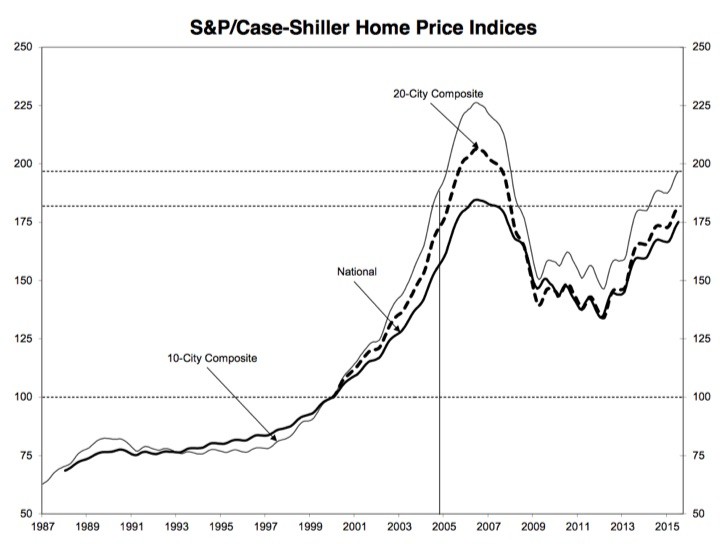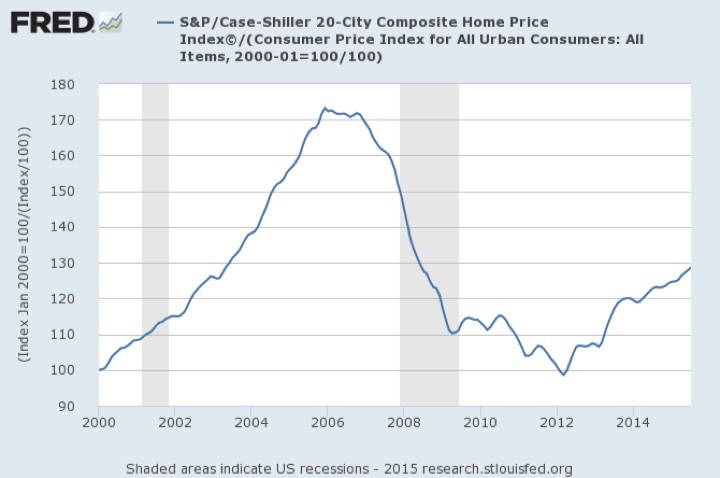 Here’s an update on residential real estate prices via the July 2015 update of the S&P/Case-Shiller Home Price Indices. Included is this chart of their 20-City Composite Home Price Index, which tracks the value of residential real estate in 20 metropolitan areas of the US:
Here’s an update on residential real estate prices via the July 2015 update of the S&P/Case-Shiller Home Price Indices. Included is this chart of their 20-City Composite Home Price Index, which tracks the value of residential real estate in 20 metropolitan areas of the US:

Overall, the S&P/Case-Shiller U.S. National Home Price Index recorded a 4.7% increase over the last 12 months. You can check more cities in the PDF, but the ones with the highest gains over the past 12 months are San Francisco at 10.4%, Denver at 10.3%, and Dallas at 8.7%.
What do home prices look like after being adjusted for inflation? We all tend to think of house prices in terms of nominal values. For example, I bought my first house in 2007 (of course) and I’ll always remember my original purchase price. But that was 8 years ago and even though inflation hasn’t been high it has still been inching along. From June 2007 to June 2015, inflation rose 12% (CPI-U).
As shared in previous updates, here is the Shiller 20-City index adjusted for inflation (CPI-U). Both data sets are not seasonally-adjusted and scaled to 100 as of January 2000.

Home prices are rising even after accounting for inflation, but this bottom chart presents a more tempered view of things.
Still, I feel for first-time homebuyers faced again with housing prices that appear to march upwards every month (and potentially out of reach).
 The Best Credit Card Bonus Offers – 2025
The Best Credit Card Bonus Offers – 2025 Big List of Free Stocks from Brokerage Apps
Big List of Free Stocks from Brokerage Apps Best Interest Rates on Cash - 2025
Best Interest Rates on Cash - 2025 Free Credit Scores x 3 + Free Credit Monitoring
Free Credit Scores x 3 + Free Credit Monitoring Best No Fee 0% APR Balance Transfer Offers
Best No Fee 0% APR Balance Transfer Offers Little-Known Cellular Data Plans That Can Save Big Money
Little-Known Cellular Data Plans That Can Save Big Money How To Haggle Your Cable or Direct TV Bill
How To Haggle Your Cable or Direct TV Bill Big List of Free Consumer Data Reports (Credit, Rent, Work)
Big List of Free Consumer Data Reports (Credit, Rent, Work)
Home prices are rising but affordability is bolstered by interest rates, which remain low. When I bought my first house I got a mortgage rate of 6.5%, which historically speaking is a pretty good mortgage rate. At that rate, your monthly payment only buys about 85% of the house that you can buy today with a 4% mortgage rate. This raises the question of what will happen to home prices if and when mortgage rates rise back to historical norms.